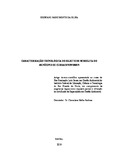Caracterização tecnológica do rejeito de sheelita do Município de Currais Novos/RN

Visualizar/
Data
2019-12-09Autor
Silva, Geovane Nascimento
http://lattes.cnpq.br/3862208969357279
http://lattes.cnpq.br/3946223809924016
Barbosa, Cleonilson Mafra
Metadado
Mostrar registro completoResumo
The present study aims to identify an alternative for the Scheelite tailings reuse
from a mine located in Currais Novos / RN, as a way to minimize environmental impacts. At
the height of Scheelita's exploration the concentrated material was superior to the tailings. By
contrast, this picture has now reversed, making tailings piles a big problem. This waste has a
large amount of Calcite, which makes it relevant because it is used in the cement, paper and
related industries; All this material is wasted due to the lack of optimization and modernization
of equipment used by mining companies in beneficiation. The acquired tailings sample was
sieved and added to H2SO4 to undergo the leaching process, and then sent for analysis by EDX,
which identifies which oxides are present. Chemical characterization reveals that the tailings
have important oxides and can be used as aggregates in industry, contributing to sustainable
development. As an example, we have the most abundant oxide in the test results, Calcium
Oxide (CaO) that can be used in construction. Because the material is a tailings sample, WO3
was identified only after ninety-six hours of leaching with a low percentage. These results
underscore the importance of analyzing mineral tailings to assist in the development of
discussions and practices that encompass natural resources with sustainable practices avoiding
waste.



